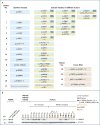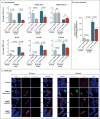ARMC5 mutations in macronodular adrenal hyperplasia with Cushing's syndrome
- PMID: 24283224
- PMCID: PMC4727443
- DOI: 10.1056/NEJMoa1304603
ARMC5 mutations in macronodular adrenal hyperplasia with Cushing's syndrome
Abstract
Background: Corticotropin-independent macronodular adrenal hyperplasia may be an incidental finding or it may be identified during evaluation for Cushing's syndrome. Reports of familial cases and the involvement of both adrenal glands suggest a genetic origin of this condition.
Methods: We genotyped blood and tumor DNA obtained from 33 patients with corticotropin-independent macronodular adrenal hyperplasia (12 men and 21 women who were 30 to 73 years of age), using single-nucleotide polymorphism arrays, microsatellite markers, and whole-genome and Sanger sequencing. The effects of armadillo repeat containing 5 (ARMC5) inactivation and overexpression were tested in cell-culture models.
Results: The most frequent somatic chromosome alteration was loss of heterozygosity at 16p (in 8 of 33 patients for whom data were available [24%]). The most frequent mutation identified by means of whole-genome sequencing was in ARMC5, located at 16p11.2. ARMC5 mutations were detected in tumors obtained from 18 of 33 patients (55%). In all cases, both alleles of ARMC5 carried mutations: one germline and the other somatic. In 4 patients with a germline ARMC5 mutation, different nodules from the affected adrenals harbored different secondary ARMC5 alterations. Transcriptome-based classification of corticotropin-independent macronodular adrenal hyperplasia indicated that ARMC5 mutations influenced gene expression, since all cases with mutations clustered together. ARMC5 inactivation decreased steroidogenesis in vitro, and its overexpression altered cell survival.
Conclusions: Some cases of corticotropin-independent macronodular adrenal hyperplasia appear to be genetic, most often with inactivating mutations of ARMC5, a putative tumor-suppressor gene. Genetic testing for this condition, which often has a long and insidious prediagnostic course, might result in earlier identification and better management. (Funded by Agence Nationale de la Recherche and others.).
Figures




Comment in
-
Heredity and cortisol regulation in bilateral macronodular adrenal hyperplasia.N Engl J Med. 2013 Nov 28;369(22):2147-9. doi: 10.1056/NEJMe1312792. N Engl J Med. 2013. PMID: 24283229 No abstract available.
Similar articles
-
A novel pathogenic variant of ARMC5 in a patient with primary bilateral macronodular adrenal hyperplasia: a case report.BMC Endocr Disord. 2022 Aug 22;22(1):211. doi: 10.1186/s12902-022-01128-x. BMC Endocr Disord. 2022. PMID: 35996143 Free PMC article.
-
Molecular and clinical evidence for an ARMC5 tumor syndrome: concurrent inactivating germline and somatic mutations are associated with both primary macronodular adrenal hyperplasia and meningioma.J Clin Endocrinol Metab. 2015 Jan;100(1):E119-28. doi: 10.1210/jc.2014-2648. J Clin Endocrinol Metab. 2015. PMID: 25279498 Free PMC article.
-
Macronodular adrenal hyperplasia due to mutations in an armadillo repeat containing 5 (ARMC5) gene: a clinical and genetic investigation.J Clin Endocrinol Metab. 2014 Jun;99(6):E1113-9. doi: 10.1210/jc.2013-4280. Epub 2014 Mar 6. J Clin Endocrinol Metab. 2014. PMID: 24601692 Free PMC article.
-
The mutational landscape of ARMC5 in Primary Bilateral Macronodular Adrenal Hyperplasia: an update.Orphanet J Rare Dis. 2025 Feb 5;20(1):51. doi: 10.1186/s13023-025-03554-1. Orphanet J Rare Dis. 2025. PMID: 39910635 Free PMC article. Review.
-
Diagnosis and management of primary bilateral macronodular adrenal hyperplasia.Endocr Relat Cancer. 2019 Oct 1;26(10):R567-R581. doi: 10.1530/ERC-19-0240. Print 2019 Oct 1. Endocr Relat Cancer. 2019. PMID: 32053747 Review.
Cited by
-
A novel pathogenic variant of ARMC5 in a patient with primary bilateral macronodular adrenal hyperplasia: a case report.BMC Endocr Disord. 2022 Aug 22;22(1):211. doi: 10.1186/s12902-022-01128-x. BMC Endocr Disord. 2022. PMID: 35996143 Free PMC article.
-
Corticotropin-releasing hormone test predicts the outcome of unilateral adrenalectomy in primary bilateral macronodular adrenal hyperplasia.J Endocrinol Invest. 2024 Mar;47(3):749-756. doi: 10.1007/s40618-023-02204-2. Epub 2023 Oct 5. J Endocrinol Invest. 2024. PMID: 37796369 Free PMC article.
-
The Association of ARMC5 with the Renin-Angiotensin-Aldosterone System, Blood Pressure, and Glycemia in African Americans.J Clin Endocrinol Metab. 2020 Aug 1;105(8):2625-33. doi: 10.1210/clinem/dgaa290. J Clin Endocrinol Metab. 2020. PMID: 32436940 Free PMC article.
-
Hyperplasia in glands with hormone excess.Endocr Relat Cancer. 2016 Jan;23(1):R1-14. doi: 10.1530/ERC-15-0171. Epub 2015 Sep 25. Endocr Relat Cancer. 2016. PMID: 26407873 Free PMC article. Review.
-
Diurnal Plasma Cortisol Measurements Utility in Differentiating Various Etiologies of Endogenous Cushing Syndrome.Horm Metab Res. 2016 Sep;48(10):677-681. doi: 10.1055/s-0042-115644. Epub 2016 Sep 19. Horm Metab Res. 2016. PMID: 27643448 Free PMC article.
References
-
- Hsiao HP, Kirschner LS, Bourdeau I, et al. Clinical and genetic heterogeneity, overlap with other tumor syndromes, and atypical glucocorticoid hormone secretion in adrenocorticotropin-independent macronodular adrenal hyperplasia compared with other adrenocortical tumors. J Clin Endocrinol Metab. 2009;94:2930–7. - PMC - PubMed
-
- Lacroix A. ACTH-independent macronodular adrenal hyperplasia. Best Pract Res Clin Endocrinol Metab. 2009;23:245–59. - PubMed
-
- Swain JM, Grant CS, Schlinkert RT, et al. Corticotropin-independent macronodular adrenal hyperplasia: a clinicopathologic correlation. Arch Surg. 1998;133:541–5. - PubMed
-
- Reznik Y, Allali-Zerah V, Chayvialle JA, et al. Food-dependent Cushing’s syndrome mediated by aberrant adrenal sensitivity to gastric inhibitory polypeptide. N Engl J Med. 1992;327:981–6. - PubMed
-
- Libé R, Coste J, Guignat L, et al. Aberrant cortisol regulations in bilateral macronodular adrenal hyperplasia: a frequent finding in a prospective study of 32 patients with overt or subclinical Cushing’s syndrome. Eur J Endocrinol. 2010;163:129–38. - PubMed
Publication types
MeSH terms
Substances
Supplementary concepts
Grants and funding
LinkOut - more resources
Full Text Sources
Other Literature Sources
Medical
Molecular Biology Databases
